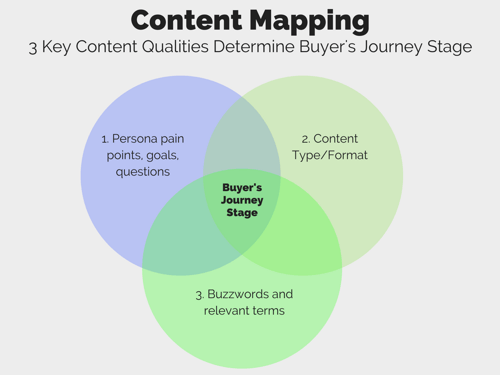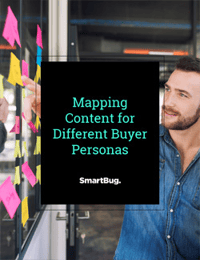
Mapping Your Content to the Buyer's Journey
January 21, 2016
By Rachel Moore
If you’ve read this blog – or really anything about inbound or content marketing strategies before – you’ve probably heard about the importance of mapping content to the Buyer’s Journey at least 100 times. And guess what? You’re likely to hear about it at least another 100 times in 2016. Why? Because knowing who your buyer personas are and where they are in their Buyer’s Journey really is just that important when it comes to creating successful inbound strategies.
If you want to read about the basics of buyer personas, the Buyer’s Journey, or coming up with snappy content ideas, then you’re in the wrong place. Check out these great posts instead:
- The 3 Stages of a Typical Buyer's Journey
- Why Every Inbound Marketer Needs to Use Buyer Personas
- Content Marketing 101: How to Decide Which Piece of Content to Write First
- 7 Tips for Creating Irresistible Content Marketing Offers
If you want to read about an actionable, concrete strategy for actually taking existing or not-yet-created content ideas and mapping them to where they are in the Buyer’s Journey, then you’re in the right place.
The three-part strategy outlined below will help you identify what characteristics of a piece of content classify it as being relevant for a particular stage of the Buyer’s Journey. This strategy can be used when performing a content inventory and trying to identify where existing pieces fit in, as well as to serve as inspiration for what you should create next to ensure you have well-rounded content coverage for every persona in every stage. 
Content Mapping:
The three key content qualities that determine Buyer’s Journey stage
Below are the three key qualities of a piece of content that will determine where in the Buyer's Journey it falls or will be applicable. The qualities are:
- The persona pain points, goals, and questions the content addresses (and how)
- The type or format of the piece of content
- Buzzwords and relevant terms used in the title and/or overarching content premise
By identifying how a piece of content (or content idea) stacks upon these three qualities, you'll be able to bring into focus exactly what stage of the buyer's journey it falls into. Let's look into a bit more detail at each one:
1. Persona pain points, goals, and questions
Each of your personas will have a slightly different Buyer's Journey leading up to making a purchase or investment with your organization. As such, the questions each of those personas ask throughout the process will differ between them -- and will also be different across the three stages of the Buyer's Journey, as well.
In the awareness stage, personas are seeking educational, vendor-neutral content that's focused around a particular problem at hand or potential opportunity. People's goals when in the awareness stage (and what you should assist with via the content you create) are to research and decide if their problem at hand is solvable or an opportunity really exists, as well as to start to identify what criteria are important for them in a solution to that problem or means to that opportunity.
In the consideration stage, users (your personas) have identified that their problems or opportunities are real and have clearly defined them. Now, they're looking for specific solutions. They're exploring all avenues and all options across all vendors, as well as starting to hone in on specific solution sets. In the decision stage, personas have chosen a solution and are now investigating solution vendors -- effectively, what product or service they'll use to deliver or obtain their desired solution.
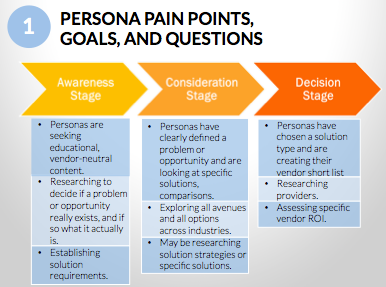
What does all of this have to do with content mapping? Well, the ways that a piece of content talks about (or, if it hasn't yet been created, could talk about) the issue at hand can (and should be) be a good indication of where that piece of content falls in the Buyer's Journey.
For example, if you're a social media scheduling software company (think Buffer App or Hootsuite), the overarching problem your personas have is that they're looking for more ROI from their social endeavors and to make message scheduling and social interaction easier. For you, a piece that talks about comparing different social publishing software tools is likely decision stage, whereas a piece comparing hiring a social media consultant versus automating publishing may be more consideration stage. Both pieces are talking about the same overarching issue but are approaching it from different angles and, thus, would likely fall into different stages of the Buyer's Journey.
2. Content type or format
Generally speaking, content in specific stages of the Buyer's Journey tends to perform best -- or at least more often be found as -- specific content types or formats. Thinking back to specifically what defines each stage of the Buyer's Journey, this shouldn't be surprising. In the awareness stage, people are interested in high-level education. As such, content formats such as e-books, guides, and tip sheets tend to be more common in this stage and generally perform well.
In the consideration stage, personas have identified their problem and are now interested in more detailed information about specific solutions. Here, things such as expert webinars, checklists, or even solution comparison whitepapers (i.e., things that allow people do dig deeper into those solutions) tend to stand out as winners. Product and vendor comparisons come into play in the decision stage, so it's not until this final stage of the Buyer's Journey when things such as product spec sheets and line cards tend to be used to greatest effect.
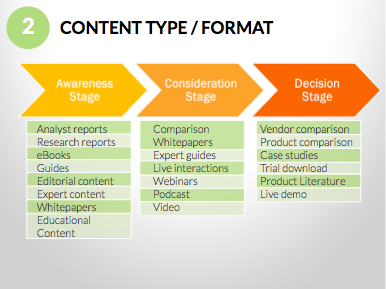
In terms of mapping content, you can use the general link between certain formats and buyer's journey stages to get an idea for where a piece of existing content may fall, or to serve as a spark of inspiration when you're wondering what to create to fill in a content gap in a particular stage. While the link between content format and buyer's journey stage isn't as hard and fast as that between buyer persona pain point, goal, or question (since precisely where something falls isn't about what shape it takes but instead what it talks about), using format as a benchmark for determining where something falls can be very useful.
3. Buzzwords or relevant terms used in the content title or premise
What are the main terms you’re talking about in this piece of content? Buzzwords such as “versus,” “troubleshoot,” “compare,” and so on tend to pop up in content in specific stages of the Buyer’s Journey. That can be useful if we’re trying to figure out what stage an existing piece of content fits in, but it's also useful when creating new content because it gives you an easy place to start talking about a certain topic.
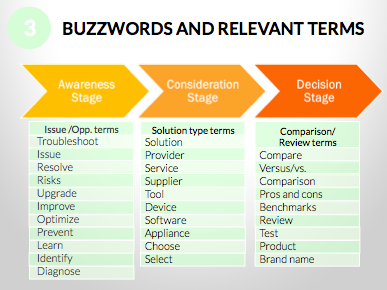
Generally speaking, content that uses terms such as "learn," "identify," and the like -- or talks about those topics -- is likely awareness stage content because those terms encompass personas' goals at the beginning of the Buyer's Journey. The same goes for content that discusses "choosing" or "selecting" "solutions" or "providers"; again, these terms harken back to the core definition of the consideration stage (i.e., researching potential solutions to a now-identified problem or opportunity).
Though using buzzwords to identify what stage of the Buyer's Journey a piece of existing content falls into isn't foolproof (you should use criteria Nos. 1 and 2 listed above, as well), it is a great way to get ideas for new content you may want to create. Need to create an awareness stage piece of content for a persona currently underrepresented on your content bookshelf? Just combine one of the awareness stage buzzwords listed above with the topic you're interested in talking about, and voila: a ready-made content idea.
Content Mapping in Action
Let's take a look at an example of how the three content fundamentals -- persona pain points, goals, or questions discussed; content type or format; and the use of buzzwords or relevant terms a title or overarching premise -- can be used to identify what stage of the Buyer's Journey a piece of unknown content falls into:

As we can see in the above example, by identifying where a piece of unknown content falls on each of the three fundamental content criteria, we can easily map it to the Buyer's Journey. Use this technique when auditing your existing content, as well as to create new pieces of content moving forward.

About the author
Rachel Moore was formerly a Senior Consultant and Team Leader at SmartBug Media. A HubSpot alumna, Rachel uses her 7+ years of experience as a marketer and neuroscientist to help clients develop innovative strategies to achieve and exceed their business goals. Read more articles by Rachel Moore.




